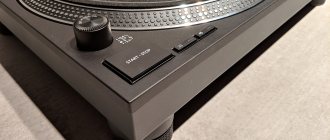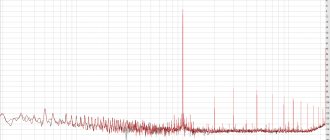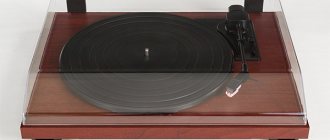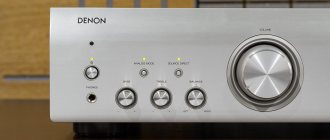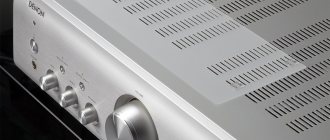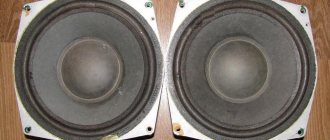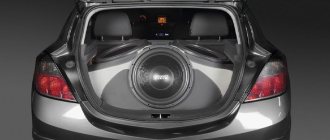Denon mini and micro systems were popular in those ancient times when everyone had forgotten about vinyl and digital music had not yet been taken seriously. Miniature proprietary components were capable of much and confidently competed with full-size Hi-Fi in the budget and mid-range segment. A lot of time has passed since then, but the compact Hi-Fi from Denon is still in demand and has a regularly updated lineup. I think it's time to study this phenomenon using a specific example and try to identify the reason for the success of these kids.
Distinctive features:
The new D-M41 mini system builds on the success of the legendary M-D40 and features improved sound, new style and features. The addition of Bluetooth allows you to instantly access the system from a smartphone, tablet or computer to select and play music and control audio. However, Bluetooth can be turned off to reduce its impact on the sound of other sources when not in use. The new design incorporates the design and functionality of Denon's flagship NE line. The RCD-M41 central unit now features two digital optical inputs for connecting your TV, set-top box or other digital device that deserves high-quality sound, and also has a built-in CD and FM/AM radio. The set for high-quality sound reproduction is completed by a new set of acoustics SC-M41
Small forms
The Denon D-M41 mini-system is extremely compact and can easily fit on a shelf, chest of drawers or cabinet for AV equipment next to the TV. But if you decide to listen to music seriously and thoughtfully, and not in the background, when the sound is pouring from somewhere far away, the listening distance must be chosen in accordance with the scale of the system. I listened to her from a distance of about one and a half meters.
The shelf holders are very compact and the standard stand is too big for them
The same can be said about music: it is better to choose compositions without much scope. If the recording lacks deep bass and the system does not need to recreate large-scale sound objects, it is completely impossible to understand whether it is children playing or a full-size mid-range hi-fi. In the mid and high frequencies, the Denon D-M41 demonstrates excellent dynamics and unexpectedly high resolution. Only the upper bass is reproduced, and in the lower registers the system is ineffective, so the scale of symphonic works and the drive of rock hits cannot be felt. The same AC/DC sound very neat and subtle. In a word, the RCD-M41 has a subwoofer output for a reason.
With grills the speakers look very neat
With electronic music, not everything is so simple. Some dance hits, in which the main rhythm is written quite high, sound absolutely full and do not make you want to connect a subwoofer.
The ideal content for the Denon D-M41 is audiophile recordings with female vocals. For example, “Ain't no sunshine” by Christy Baron sounds great - very expressive, articulate, and detailed. The fullness of dynamic capabilities was felt on the album version of “Run” by Guru Groove Foundation. The pulsating keyboards, high-gated kick drum and dry, crisp percussion sound very rhythmic. And another hit called “Moscow” is best listened to not from the first album, but in an acoustic cover version from 2022, with dominant percussion and guitars.
The bass reflex is integrated into the module with terminals
And of course you can’t ignore the recordings of great guitarists. Tommy Emmanuel and Al Di Meola recorded their hits as if especially for such a scale. This is where the microsystem gets the opportunity to demonstrate all its advantages: expressiveness of the midrange, purity of the upper frequencies, rhythm and dynamics, high detail.
Characteristics
- Output power 2 x 30 W, class A/B amplifiers
- Playback CD-Audio, CD-R/RW (MP3, WMA)
- Bluetooth yes
- Inputs 2 digital optical, analog
- Outputs for subwoofer, headphones (mini-jack 3.5 mm, separate circuit), acoustics (screw)
- Adjusting the tone of bass, treble
- Optional Super Dynamic Bass boost circuit
- FM tuner (87.5 - 108 MHz), RDS, memory for 40 stations
- Remote control available
- There is a clock with an alarm clock
- There is an auto-shutdown timer
- Acoustics SC-M41, bookshelf two-way
- Woofer 120 mm
- 25mm tweeter, soft fabric dome
- AC frequency range 45 Hz - 40 kHz
- AC impedance 6 ohms
- Dimensions (W x H x D) 210 x 115 x 309 mm (main unit), 145 x 238 x 234 mm (column)
- Weight 4 kg (main unit), 3.6 kg (speaker)
For the sake of sound quality
The Denon D-M41 minisystem looks very nice and at first glance may seem frivolous. But this impression is wrong. Hidden in miniature sizes is a real monster, assembled according to High End canons. Inside is a fully discrete Class AB amplifier rated at 30W per channel.
A CD receiver requires minimal shelf space
The circuit design and layout are implemented using Denon Triple Noise Reduction Design technology, which involves noise reduction in three ways: shielding, separation of digital and analog circuits, and adherence to short path principles, when signal paths are minimized as much as possible. In a word, it’s no wonder that the design of this mini CD receiver is so reminiscent of the design of Denon’s latest generation of High-End components New Era.
The built-in CD drive reads not only CD-DA, but also discs with MP3 and WMA files
The acoustics have a 25 mm soft fabric dome tweeter, like a large Hi-Fi acoustic, and a 120 mm mid/bass driver with a large dust cap in the center. The acoustic design is bass reflex - a small-diameter port is brought to the rear. What is characteristic is that the bass reflex does not produce overtones even when installed close to the wall. The connection is made with large screw terminals, which allows you to replace thin standard cables with something more solid and audiophile-grade with a large cross-section.
Going beyond
No matter how good the Denon D-M41 microsystem sounds, its most likely fate is as background sound in bedrooms and offices. But it would not be fair to deprive her of the chance to prove herself in higher spheres, so in addition to the main audition, I conducted a number of experiments.
Connecting a subwoofer changes the sound picture completely, extending the system's capabilities to full-size Hi-Fi. Here everything depends mainly on the capabilities of the additional low-frequency link and its ability to match the frequency of the natural decline in the output of Denon SC-41 bookshelf speakers. This is the most direct and obvious way.
Miniature speakers have a standard 25mm tweeter
Another option is to replace the acoustics with larger and more expensive bookshelf speakers with a lower bass response roll-off frequency. This will give benefits in all characteristics, especially in the lower mids and bass, but at high volumes the amplifier will have a hard time. However, if you can install a full-size Hi-Fi, but want more bass, I think it’s quite possible to find bookshelf speakers that match the characteristics and are superior in sound to the standard ones. However, the system budget will double or even triple. After all, the entire Denon D-M41 set costs the same as a pair of mid-range bookshelf speakers.
Small mid/bass driver produces very dynamic and clear sound
Another bolder attempt to improve sound is to replace the built-in CD player with an external one, comparable in cost to the RCD-M41 CD receiver itself. The connection was made first with an optical and then with an analog cable. In both cases, the external CD player was noticeably inferior to the built-in one. This means that the built-in one is at least a class high, and it feels even two classes higher. The situation is the same as with replacing the speakers. It is possible to improve the sound, but the costs increase many times over.
The general conclusion is simple and obvious: Denon D-M41 are very good in their price niche, but to get even better sound, the budget will have to be radically revised.
Denon acoustics are quite rare
But if, in addition to classic Hi-Fi, you also love personal audio, put your High-End headphones away and look for something simpler in stock. The corresponding output of the CD receiver is designed more for inexpensive models with a dark and bassy sound - with them it plays best. With my studio headphones, I got a very crowded sound, collected somewhere in the center of the head, almost without bass and with a raised middle. The resolution did not impress me as much as it did when listening to the speakers. In a word, everything sounded no better than the average smartphone.
Full-length terminals allow the use of large cross-section speaker cables
But with simpler headphones, a reverse metamorphosis occurred. Compared to their sound on the same smartphone, everything has changed for the better. The microsystem in these headphones produced clearer, more prominent and focused sound; the bass picked up and became more manageable; only the stage remained as before without the feeling of width and volume, as was the case with more expensive headphones.
Equipment
Even if the rest of the kit remained unchanged, the first-ever inclusion of Bluetooth support in the line's history (which can be turned on or off to avoid affecting the D-M41DAB's sound when not in use) is reason enough to celebrate.
The lack of wireless functions did not prevent us from presenting well-deserved Awards to Denon models, but this was the only blemish on the line’s impeccable biography.
Given the many advantages of the D-M40DAB, the company's engineers took a lot of risks by taking on the task of reworking the internals of their flagship microsystem.
Denon says its new analog amplifier circuit improves sound clarity, while shorter signal paths and other measures help avoid internal interference.
These innovations are part of Denon's Triple Noise Canceling System, which also includes careful separation of analog and digital circuits and precision grounding.
In addition, the company claims that distortion from the input selector, volume control and power amplifier are further suppressed, resulting in maximum sound clarity.
Conclusion
The Denon D-M41 microsystem is without a doubt good in its class and in its price group. The only adequate upgrade is the use of a subwoofer, but otherwise this is a completely self-sufficient package. The only thing we can blame the developers for is that they do not take the sound quality of the headphone output seriously enough. After all, modern technologies make it possible to install truly high-quality amplifiers even in limited space.
The mini-system's remote control turned out to be full-size
Otherwise, this is an ideal second system for lovers of traditional stereo. By the way, I think we need to remind you that Denon still has turntables in its range, and the Denon D-M41 has an analog input.
Advantages: high-quality sound, compact size, availability of digital and analogue inputs
Disadvantages: a subwoofer is required for full sound; replacement of standard speaker cables is highly desirable
